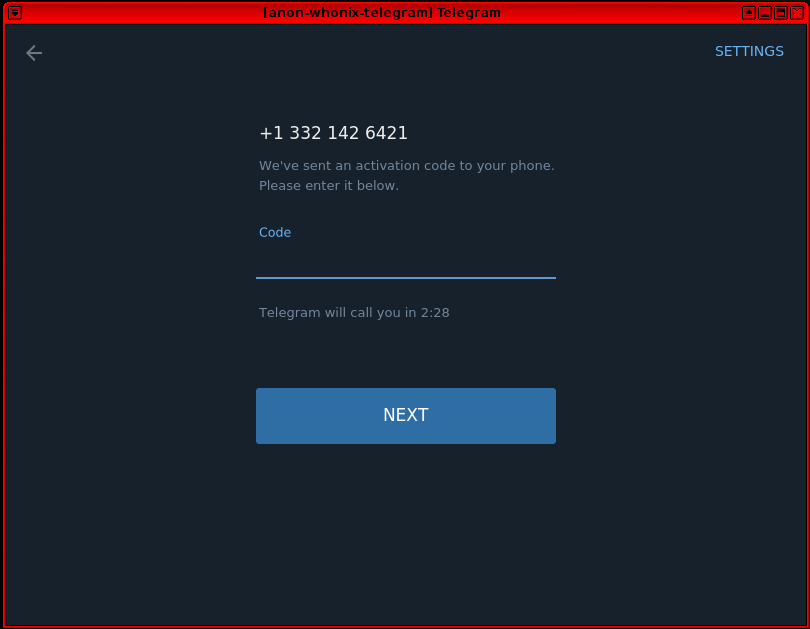Send Telegram Messages over Tor with Whonix

Use Telegram over the Tor network with Whonix.
Introduction
[edit]Telegram![]()
is a cross-platform, fully featured instant messenger. The Telegram FAQ
![]()
describes the basic architecture:
Telegram is a messaging app with a focus on speed and security, it’s super-fast, simple, and free. You can use Telegram on all your devices at the same time — your messages sync seamlessly across any number of your phones, tablets, or computers.
With Telegram, you can send messages, photos, videos, and files of any type (doc, zip, mp3, etc.), as well as create groups for up to 200,000 people or channels for broadcasting to unlimited audiences. You can write to your phone contacts and find people by their usernames. As a result, Telegram is like SMS and email combined — and can take care of all your personal or business messaging needs. In addition to this, we support end-to-end encrypted voice calls.
Advantages include: [1]
- access to chats across multiple devices
Disadvantages include:
- The application requires the user to register a phone number to create a Telegram account. See also Phone Number Validation.
- End-to-end client encryption is not enabled by default.
- The desktop and web versions have no end-to-end encryption feature. Messages from non-encrypted chats are stored on Telegram's servers and Telegram team has access to it according to section 3.3.1 of privacy policy (archived at time of writing)
 . Telegram moderators may check messages that users have reported, as stated in section 5.3 of privacy policy. Telegram notified eSafety Commissioner of the Australian Government about moderation in secret chats:[2]
. Telegram moderators may check messages that users have reported, as stated in section 5.3 of privacy policy. Telegram notified eSafety Commissioner of the Australian Government about moderation in secret chats:[2]
- The desktop and web versions have no end-to-end encryption feature. Messages from non-encrypted chats are stored on Telegram's servers and Telegram team has access to it according to section 3.3.1 of privacy policy (archived at time of writing)
Telegram stated that messages in Secret Chats were not ‘forwarded’ to moderators when they were reported by an end-user. Without access to the messages being reported, Telegram reported that it relies on alternative signals or indicators to determine if ‘the reported user is not otherwise engaging in harmful or malicious behaviour’
- The mobile version has easily confused encrypted versus non-encrypted chats.
- Telegram does not have encrypted group chats, channels and chats with bots.
- Telegram sends the user's personal data to the interlocutor to the chat: registration date (month and year), region of the phone number, common groups, and any changes to the name and avatar (if it have been changed in the past 30 days). [3]
- For the purpose of encrypted chats, it is better to use a messenger that is always encrypted end-to-end by default.
- Journalists have established a possible connection between Telegram and Russian intelligence agencies. [4]
- MTProto 2.0 has been repeatedly criticized by cryptography experts. [5]
- Telegram collects a lot of metadata: IP address, devices and Telegram apps you've used, history of username changes, etc. This metadata can be kept for 12 months, as stated in section 5.2 of privacy policy.
- Telegram cooperates with intelligence agencies and may share user data (IP address and phone number), as stated in paragraph 8.3 of the privacy policy.
This is why it is not recommended for anonymous messaging at this time.
One viewpoint is to see Telegram as a modern public chat or IRC alternative.
Telegram Data Harvesting
[edit]Telegram collects information about the operating system, sends it to the server, stores it there, and then sends a message to the user without end-to-end encryption. Here is an example:
Device : Telegram Desktop, 4.6.5 Snap, Desktop, Linux Qubes X11 glibc 2.35Telegram, service notifications [6]
This means Telegram has collected at least:
| Category | Value |
|---|---|
| Device | Telegram Desktop |
| Installation method | Snap |
| Telegram version number | 4.6.5 |
| Operating system kernel | Linux |
| Operating system | Qubes |
| Window manager | X11 |
| System libraries detected | glibc 2.35 |
This has sparked discussion among users:
- https://forum.qubes-os.org/t/how-to-hide-the-fact-that-im-qubes-os-from-telegram/22934

?
- https://forum.qubes-os.org/t/telegram-desktop-identifying-qubes-in-standalonevm/17906

- https://forums.whonix.org/t/qubes-identifiers/17994

See also: VM Fingerprinting
Telegram User Freedom Threats
[edit]As defined in User Freedom Threats![]() :
:
- Proprietary Tethers
- RegistrationRequired
- Non-freedom network service
- Enforced centralization
Installation
[edit]telegram-desktop can be installed from Debian backports. This is non-ideal, see footnote. [8]
1. Update the package lists.
sudo apt update
2. Install the select software.
sudo apt -t trixie-backports install telegram-desktop
3. Done.
The procedure of installing the package from the backports repository is now complete.
Start
[edit]To launch the application, in Whonix-Workstation™ terminal run.
telegram-desktop
Figure: Telegram Desktop in Whonix [9]
For a basic Telegram user guide refer to this official blog entry![]()
.
See Also
[edit]Footnotes
[edit]- ↑
https://telegram.org/faq

- ↑
https://www.esafety.gov.au/sites/default/files/2025-03/BOSE-responses-to-mandatory-notices-tvec-March2025.pdf

- ↑
- ↑
- ↑
- ↑
https://forum.qubes-os.org/t/telegram-desktop-identifying-qubes-in-standalonevm/17906

- ↑
telegram-desktop version in Debian stable (
buster) at the time of writing showed a warning that soon it will be no longer functional.You are using an outdated app that is no longer supported. To access your messages, please update your app to the latest version.
Hence using Debian backports version.
Not installing from telegram website since telegram does not provide digital software (gpg) signatures

.
- ↑
Users should Prefer Packages from Debian Stable Repository
 , but using backports is better than manual software installation or using third party package managers since this prefers APT. To contain the risk, Non-Qubes-Whonix users might want to consider using Multiple Whonix-Workstation™ and Qubes-Whonix™ users might want to consider using Multiple Qubes-Whonix™ Templates or Software Installation in an App Qube
, but using backports is better than manual software installation or using third party package managers since this prefers APT. To contain the risk, Non-Qubes-Whonix users might want to consider using Multiple Whonix-Workstation™ and Qubes-Whonix™ users might want to consider using Multiple Qubes-Whonix™ Templates or Software Installation in an App Qube .
.
- ↑ A false (random) phone number was utilized for this image.

We believe security software like Whonix needs to remain open source and independent. Would you help sustain and grow the project? Learn more about our 13 year success story and maybe DONATE!
















